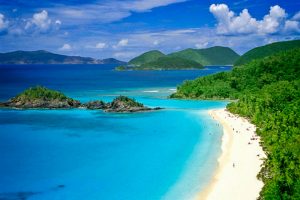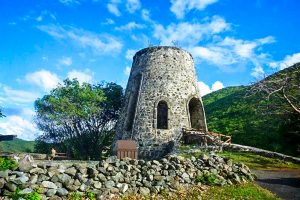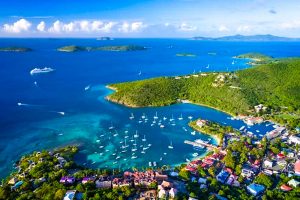An American Pearl in the Caribbean

The iconic Trunk Bay, home of the 650-foot snorkel trail (photo courtesy of Destination St. John.)
A recent edition of Travel and Leisure magazine touted St. John, in the U.S. Virgin Islands, as “one of the World’s Best.” There is good reason; it is beyond superlative.
St. John is small with a laid-back vibe and an interesting history. With no airport, the only way to reach the island is by boat. Thus, a lengthier visit is something to consider. But for a modest number of nicely designed vacation homes, there is only one significant population center, Cruz Bay. Otherwise, St. John is an extraordinary array of white-sandy beaches and azure waters as far as the eye can see.
St. John wasn’t always U.S. territory. Columbus, passing through in 1493, could have claimed the islands, but the Danes later did in the 1670s and the Danish flag flew there for more than 200 years.
During those centuries, sugar plantations using slave labor underpinned the island’s economy. St. John’s decline occurred when the sugar beets of northern climes became competitors of the white cane. When the Danes then freed their forced laborers in 1848, life on the island took a precipitous nose dive, becoming impoverished.

Ruins of the Annaberg Plantation as viewed from the historic walking trail (photo courtesy of Connie Ma and Karen Elowitt.)
In 1917 and at the height of WWI, the U.S. paid 25 million in gold to buy St. John, St. Croix and St. Thomas. The intent was to use them as naval bases.
Later, during World War II, military-related jobs revived the economy, as well as tourism that had begun to flourish in the 1950s. Philanthropist Laurance Rockefeller sailed to St. John in 1952 and was so enamored that he arranged to acquire most of the island as well as Caneel Bay Plantation to convert it into one of the first environmentally friendly resorts. The real benefit in the arrangement was tranquility, in the form of building restrictions and density control. By 1956, Rockefeller had donated 60% of the land he bought to the U.S. government.
So, make the trip to an American pearl in the Caribbean. But plan ahead: island accommodations are limited and expensive.
The shouldn’t misses:
Trunk Bay: In addition to being incomprehensibly stunning, it offers a 650-foot snorkel trail and could be the most photographed beach in the Caribbean.
Salomon Beach: A most secluded spot, it can be reached off the Lind Point Trail. Honeymoon Beach, a popular spot for families, is not far from Salomon.

Coral Bay, St. John, U.S. Virgin Islands (courtesy photo.)
Annaberg: Built in 1721, this former factory and plantation produced sugar, rum and molasses. Today, it is a museum. Nearby is Leinster Bay Trail, one of the island’s best.
Cinnamon Bay Nature Loop: Enjoy local flora and fauna and a bonus of seeing the ruins of old sugar plantations.
Peace Hill: Take an easy hike to one of the island’s highest elevations and see the ruin (also an historical landmark) of a sugar mill windmill and maybe attend a Sunday meditation. The views of the island from Peace Hill are spectacular.
Reef Bay Trail: Take a 4-mile, moderately challenging hike through island bush to see former sugar mills, some petroglyphs and end the walk at a beach.
By Joe Gschwendtner; courtesy photos